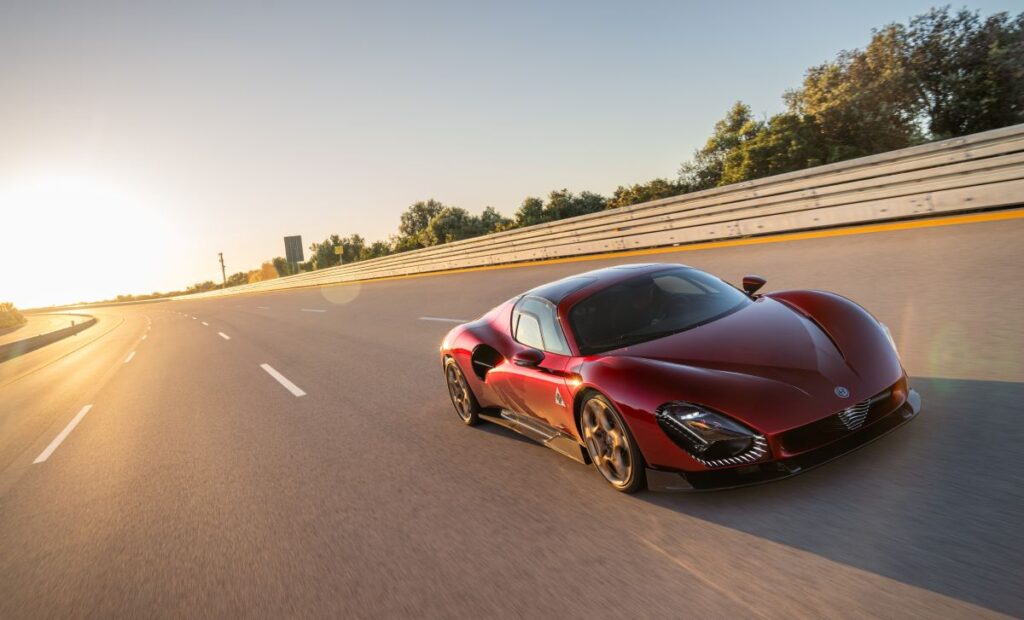
AUBURN HILLS, Mich. (November 26, 2024) – The Alfa Romeo engineering team has just completed an intense test session with the “00 prototype” of the new 33 Stradale at the Nardò circuit, to test its driving dynamics and performance in extreme high-speed conditions. Specifically, the test team monitored and validated dynamic parameters such as aerodynamics, top speed, maximum temperatures, propulsive cooling systems and cabin soundproofing. All of this ahead of the first delivery, scheduled to take place in Italy in late December.
For the type of high-speed tests to be conducted, Alfa Romeo chose the Nardò Technical Center (NTC), one of the most advanced testing and experimentation centers in the world, located in Salento, Italy. Built in 1975 by FIAT, the Puglia ‘proving ground’ covers an area of 1,730 acres and boasts 20 test tracks for experimentation and development activities at any level.
Of these tracks, the famous Nardò Ring stands out for high-speed tests of cars and motorcycles, with its diameter of 2.5 miles (4 km) and length of 7.8 miles (12.6 km). Considered the fastest circular car track in the world, the circuit offers different inclines and relative compensation speeds on each of its four lanes. Thanks to its low parabolic profile, driving on every lane at the compensating speed balances centrifugal force, making drivers feel like they are on an endless straight.
It was on this ring track that the Alfa Romeo team ran high-speed testing on the developmental 33 Stradale, validating the target top speed of 207 mph (333 km/h) and acceleration from 0 to 62 mph in under three seconds. This performance was made possible by the meticulous work Alfa Romeo technicians have done on the vehicle’s aerodynamics, where every line of the car’s sculptural volume is functional to obtaining the best aerodynamic performance. These advanced aerodynamics help raise the performance of the 3.0-liter twin-turbo V-6 engine, which delivers more than 620 horsepower and is paired with an 8-speed DCT gearbox that sends power to the rear wheels with assistance from an electronic limited-slip differential. The new engine is an evolution of the existing V-6 currently in the Italian brand’s highest performance cars and is mounted longitudinally in the center for exceptional performance.
The dynamic testing at the NTC follows previous testing held at the Balocco Proving Ground in Vercelli province on the iconic Alfa Romeo track. Since 1962, this track has hosted the development and preparation of the highest performance racing cars (Autodelta) that competed in international F1, DTM and Super Turismo circuits. In this historic location, the same team of Alfa Romeo engineers conducted the entire session on specific medium- and high-speed tests, with a focus on balance, braking system and road handling. At Balocco, the first test was conducted at moderate speed to evaluate the precision of the steering system and the response of the braking system, as well as the characteristic handling made up of the aluminum H-frame, the carbon-fiber monocoque and the refined configuration of the suspension.
The car offers two drive modes, which can be activated from the switches on the central tunnel: Strada (Road) and Pista (Track). The former, engaged when the car is started, ensures comfort and driving pleasure: smooth power delivery, usual pedal sensitivity, soft suspension, fluid transmission and active exhaust valves open only above 4,000 rpm. Alternatively, in Pista mode, the driver chooses an adrenaline-fueled drive: the power is at its peak, the pedals are even more responsive and the suspension is rigid, as well as offering rapid gearshifts and active exhaust valves that are always open. One of the most exciting performance controls in this configuration is the Partenza Veloce (Quick Start) procedure: by pressing the Quadrifoglio button on the central tunnel, the gearbox, traction control and power delivery are optimized to avoid wheel slippage.
On specific sections of the circuit, the Alfa Romeo testers disengaged traction control (ESC OFF), taking the car close to its top speed to confirm that the 33 Stradale manages to combine supercar performance with surprising ease of driving, even for non-professional drivers. All this is made even more evocative by the sound of the twin-turbo V-6, an authentic ‘mechanical symphony’ that wraps around the passenger compartment and conveys unique emotions while accelerating. The active suspension system also played a key role in the test, offering a perfect combination of comfort and performance. Specifically, the new custom-built car adopts a 100% Alfa Romeo dual-arm suspension scheme with active shock absorbers and semi-virtual steering on both the front and rear axles, which provides optimum control of the steering wheel and the highest degree of steering precision, as well as providing great lateral acceleration to ensure the best handling in all driving conditions.
Finally, the Balocco session highlighted the precision and capacity of the brakes to adapt to different drive modes, ensuring excellent control, so much so that the new 33 Stradale brakes from 62 mph to 0 in under 108 feet. All made possible by the built-in Alfa Romeo Brake-By-Wire braking system, which controls both braking pressure and pedal feel. Produced by Brembo, the carbon-ceramic brakes execute repetitive high-performance stops and ensure reactive braking with a reduced fading effect at high temperatures. In the front and rear, the discs are ventilated and perforated, with a six-piston aluminum monobloc caliper in the front and a four-piston system in the rear.
Leave a Reply
You must be logged in to post a comment.